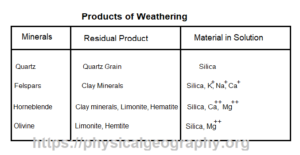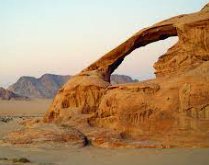Weathering is the breakage and detachment of the sediments, particles, and granules from the surface of rocks. Weathering is a continuous and regular process, which is composed of many underlying processes, which are directly concerned with weathering.
Weathering: The rocks break and undergo decay under the influence of atmospheric agencies like wind, sun, frost, water, and organisms, and produce soil. This phenomenon is called weathering. Weathering and Erosion together lower the mountains and produce sediments. The weathering may be defined as the process which tends to break and decompose rocks in place. It includes two processes: (i) “disintegration” or physical breaking, and (ii) “decomposition” chemical decay. In nature, these two processes work simultaneously.
Erosion: Erosion is a process, that includes the destruction of existing rocks and the removal of the product from the site of destruction. Transport is an important aspect of erosion. It is usually done by water, wind, and ice.
Denudation: The combined effect of weathering and erosion is called “denudation”. It involves the general wearing down of the earth’s surface.
Exfoliation: It is mainly the physical weathering process in which large sheets of rock peel off from an outcrop. In exfoliation, reduction in pressure due to the removal of the overlying rock plays an important part. As each slab breaks off, it releases weight from the underlying mass. As a result, its outer layers expand and separate from the rock mass. Exfoliation is commonly seen in homogenous rocks like granite.
Spheroidal Weathering: If an outcrop of jointed rock is subjected to chemical weathering, the rounded boulders are produced. This process is called “Spheroidal Weathering”. The spheroidal weathering resembles exfoliation except that it takes place on a much smaller scale. In spheroidal weathering, the hydration which is accompanied by an increase in volume, plays an important part. As the minerals in rock weather to clay, they increase in size because of the addition of water into their structure. The increase in volume exerts an outward force due to which the concentric layers of rock break loose and fall off.
Types of Weathering
There are three main types of weathering; (i) Physical, (ii) Chemical, and (iii) Biological Weathering.
Physical Weathering
Physical weathering (disintegration) involves the application of mechanical forces. In physical weathering, a rock breaks into smaller pieces without any chemical change. Thus by breaking rocks into smaller pieces, physical weathering increases the amount of surface area for chemical attack. The principal agents of physical weathering are (i) frost, (ii) heating and cooling, and (iii) organisms.
1. Frost Wedging
When water freezes, it expands about 9 percent of its volume. During precipitation, the water enters into cracks in rocks. Upon freezing it expands and exerts great pressure on the walls of the cracks. As a result, the rocks break into pieces. This process is called “frost wedging”. By this process, angular fragments of the rocks are broken off from the high mountain ranges. These rock fragments roll down the hill slope and accumulate in the base to form “talus deposits”.
2. Heating and Cooling
It is believed that the daily cycle of temperature change weakens the rocks, particularly in hot and dry climatic regions. Heating a rock causes it to expand and cooling causes it to contract. Repeated expansion and contraction tend to develop cracks in rocks. In desert areas, coarse-grained rocks like granite and gabbro disintegrate soon into their constituent crystals and become desert sands as a result of temperature variation.
3. Living Organisms
Plants, burrowing animals, and men play an important part in the disintegration of rocks. Plant roots grow into rock joints. As the roots grow thicker, they exert mechanical pressure and wedge the rock apart. Burrowing animals, such as earthworms, ants, and rodents also contribute to the disintegration of rocks. Men also break rocks by making road cuts, buildings, quarrying, mining, and cultivating the land.
Chemical Weathering
Chemical weathering of decomposition is a process in which rocks are broken down by chemical decay of minerals. During chemical weathering, continuous chemical reactions act on rocks, which change their minerals to unstable forms. The principal agents of chemical weathering are (i) water, and (ii) organisms.
1. Water
Water is the main agent of chemical weathering. Although water in pure form is inactive, it becomes a powerful chemical agent, when a small amount of oxygen and carbon dioxide are dissolved in it. Rainwater usually contains these gases. The main reactions that are involved in chemical weathering are (i) oxidation, (ii) carbonation, (iii) hydration, and (iv) solution.
-
- Oxidation: The oxygen present in the water in a dissolved state oxidizes some minerals. Mafic minerals like pyroxenes, amphiboles, and olivines contain some iron. During weathering the oxygen unites with the iron producing insoluble iron oxides. Limonite and hematite are very common products of oxidation, which impart red and yellow colors to soil.
- Hydration: In hydration, water molecules combine chemically with minerals to produce new compounds. The formation of gypsum (Ca SO4. H2O) from anhydrite (CaSO4) is a good example of hydration. Carbonation frequently operates along with hydration. The orthoclase feldspar, a mineral, that is abundant in granite, is decomposed and converted into kaoline by hydration and carbonation. Other hydrous silicates formed by hydration of the primary silicate, such as pyroxenes, amphiboles, and olivine are chlorite, serpentine, talc, and zeolites.
- Carbonation: Carbon dioxide dissolves in water to form carbonic acid (H2O3). Carbonic acid is an effective weathering agent. Granite is the most abundant continental rock. Under the influence of Carbonic Acid, it weathers into clay. Let us examine this process in detail.
- The granite consists mainly of quarts and potassium felspar. Quartz are very resistant to chemical weathering. Hence it remains unaltered.
- The reaction between carbonic acid and potassium felspar is as follows.
2KAlSi3O8 +2H2CO3 +H2O ————————– Al2Si2O3(OH)4 +2KHCO3+4SiO2
iii. The products of this reaction are potassium bicarbonate and clay minerals. The potassium bicarbonate being soluble is removed by ground water, while clay minerals accumulate near the surface.
The weathered products of important silicate minerals are shown in the following table. When minerals containing calcium, magnesium, sodium, and potassium react with carbonic acid, carbonates and bicarbonates are formed. These soluble products are removed by groundwater. The three remaining elements, aluminum, silicon, and oxygen join with water to produce stable clay minerals.

d. Solution: The process of solution and carbonation goes on together. The limestones, dolomites, rock salt, and gypsum are particularly susceptible to the solution when they are attacked by water containing carbon dioxide.
2. Organisms
Many organisms produce organic acids as they decay. These acids increase the solvent power of water. For example, the solubility of silica-alumina and iron is much greater in the presence of organic acids.
Biological Weathering
As the name suggests, biological weathering means weathering brought about by various activities of living organisms. Along with the other two types of weathering, biological weathering contributes to the further degradation of the rocks and their particles and thus makes them more susceptible to other environmental factors–biotic or abiotic factors. Biological weathering may be carried out by either physical means or chemical/organic action.
Biological Weathering by physical means
This type of weathering is caused by a force or pressure exerted on the rocks, thus disintegrating and breaking the rock particles apart. By increasing the exposed surface area of rocks, they make it possible for other physical factors to speed up their degradation. There are five main forms of biological forms involved in biological weathering;
- Plants can grow anywhere, subject to the presence of water. Roots of trees or plants in general can biologically weather rocks by growing into the cracks and fractures of rocks and soil. As a result, they become more prone to breakage and eventually fall apart.
- Burrowing animals like shrews, moles, earthworms, and even ants are important agents of biological weathering. These animals create holes in the ground by excavation and transport the rock fragments up to the surface. As a result, these particles become more susceptible to other environmental factors that can further enhance their weathering.
- Animals like birds forage for seeds and earthworms by creatinging holes and eroding the upper surface of the soil, thus, contributing to weathering.
- An animal called the Piddock shell can drill into rocks in order to protect itself. They can disintegrate the rock, turn it into fragments, and create cracks and fractures and eat the minerals found in it. They perform this job by the pouring acid on the rocks.
- Like any other animal, humans can also directly as well as indirectly contribute to biological weathering. Merely, by walking and running, humans crush the large particles of rocks into fine grains. Other human activities such as planting and cutting rock sides for construction of the roads can also contribute to biological weathering.
1. Biological weathering employing chemical/organic materials
In this type of weathering, living organisms contribute through their organic compounds that contain molecules that acidify and corrode rock minerals. Because of such a mechanism, biological weathering is also referred to as organic weathering. This type of weathering can happen in the following ways;
- When the roots of plants grow deeper into the soil, they tend to create cracks and crevices in marbles and limestones by producing certain acids that can eventually degrade them.
- According to studies, the mere presence of roots in the soil can wear out soil and rocks through the presence of humus. Humus is an organic component of soil, formed by the decomposition of leaves and other plant material by soil microorganisms. It can increase the availability of water, which then enhances the physical and chemical breakdown of rocks.
- When plants die, their roots (and other parts as well) are decomposed and are later converted to organic matter which produces carbon dioxide. This carbon dioxide (CO2 ), when combined with water (H2O), produces weak carbonic acid, which can degrade the surfaces of rocks and rock particles.
- While ants and termites are major agents of biological weathering. They can contribute to the physical breakdown of rocks by creating holes and passages in the ground. These animals increase the possibility of easy passage of oxygen and water to the soil, which in turn, brings the dissolution of soil, rocks, and rock particles alike.
- When animals die, their bodies are converted to substances. These substances, when combined with minerals found in the soil and rocks, can increase the vulnerability of the rocks.
2. Biological Weathering by micro-organisms
Despite their minute size, some microorganisms can break down the largest, and even hardest rocks into soil.
- One example of such activity is exhibited by lichens. A lichen is a composite organism that arises from algae or cyanobacteria living among filaments of multiple fungi species in a mutualistic relationship. Lichens also have a significant impact on the chemical weathering of rocks by the excretion of various organic acids, particularly oxalic acid, which can effectively dissolve minerals and chelate metallic cations.
- Fungi are essential drivers of biogeochemical cycles at the Earth’s surface. They are involved in both rock weathering and neogenesis of minerals, the latter and as by-products of their impact during alteration. The minerals in rocks are liberated when a fungus releases chemicals. This release of chemicals can break them down. Such minerals are then consumed by the alga, further causing the wearing and development of cracks and gaps in the rock. As a result, cracked rocks become more prone to disintegration.
- Some fungi produce siderophores, a type of chelating agent that can absorb various minerals and nutrients from the soil. By trading cations for hydrogen ions, siderophores make the soil more acidic and, hence more prone to degradation.
- Another good example of biological weathering of rocks is by a group of bacteria called Actinomycetes. According to a study published in the Journal of Microbial Ecology, these bacteria through acid production, mineral solubilization, and metal leaching have successfully degraded rocks in Egypt.
